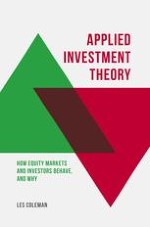2016 | OriginalPaper | Buchkapitel
6. Structure of Equity Prices
verfasst von : Les Coleman
Erschienen in: Applied Investment Theory
Aktivieren Sie unsere intelligente Suche, um passende Fachinhalte oder Patente zu finden.
Wählen Sie Textabschnitte aus um mit Künstlicher Intelligenz passenden Patente zu finden. powered by
Markieren Sie Textabschnitte, um KI-gestützt weitere passende Inhalte zu finden. powered by
Abstract
-
Equity prices have roughly lognormal price distribution, with sufficient regularity for investors to capture abnormal returns
-
Equities’ demand curve has a time-varying slope that can turn positive like a Veblen good so that prices move pro-cyclically (i.e. trend)
-
Links identified between equity return and lagged values of systematic and firm-specific factors are ex post explanations. They are unstable and noisy, and have little ex ante ability to predict returns over investors’ time horizon
-
Investors do not have predictive skill, and ex post will not be judged as unconditionally making optimum decision choices.
-
Empirical evidence is that intuitively price-sensitive public information explains relatively little of the return to equities, whose prices usually move in the absence of new information.
-
Humans control virtually all market information and have discretion in timing some of the most important data
-
Price-insensitive investment managers who dominate ownership of equities are monopsonistic buyers, which leads to a classic sawtooth price pattern
